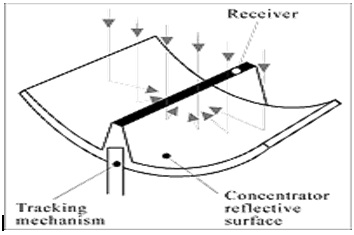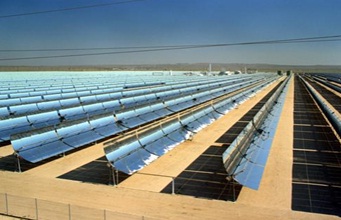





Published on Feb 14, 2025
Concentrating, or focusing, collectors intercept direct radiation over a large area and focus it onto a small absorber area. These collectors can provide high temperatures more efficiently than flat-plate collectors, since the absorption surface area is much smaller.
However, diffused sky radiation cannot be focused onto the absorber. Most concentrating collectors require mechanical equipment that constantly orients the collectors toward the sun and keeps the absorber at the point of focus. Therefore; there are many types of concentrating collectors [2]. Solar energy is an abundant and renewable energy source.
The annual solar energy incident at the ground in India is about 20,000 times the current electrical energy consumption. The use of solar energy in India has been very limited. The average daily solar energy incident in India is 5 kWh/m 2 day and hence energy must be collected over large areas resulting in high initial capital investment; it is also an intermittent energy source.
Hence solar energy systems must incorporate storage in order to take care of energy needs during nights and on cloudy days. This results in further increase in the capital cost of such systems.Solar power is the conversion of sunlight into electricity, either directly using photovoltaics (PV), or indirectly using concentrated solar power (CSP). Concentrated solar power systems use lenses or mirrors and tracking systems to focus a large area of sunlight into a small beam. Photovoltaics convert light into electric current using the photoelectric effect
The term is applied to solar hot water panels, but may also be used to denote more complex installations such as solar parabolic, solar trough and solar towers or simpler installations such as solar air heat. The more complex collectors are generally used in solar power plants where solar heat is used to generate electricity by heating water to produce steam which drives a turbine connected to an electrical generator.
The simpler collectors are typically used for supplemental space heating in residential and commercial buildings. A collector is a device for converting the energy in solar radiation into a more usable or storable form. The energy in sunlight is in the form of electromagnetic radiation from the infrared (long) to the ultraviolet (short) wavelengths. The solar energy striking the Earth's surface depends on weather conditions, as well as location and orientation of the surface, but overall, it averages about 1,000 watts per square meter under clear skies with the surface directly perpendicular to the sun's rays.
Solar collectors fall into two general categories: non-concentrating and concentrating. In the non-concentrating type, the collector area (i.e. the area that intercepts the solar radiation) is the same as the absorber area (i.e., the area absorbing the radiation). In these types the whole solar panel absorbs the light.Flat plate and evacuated tube solar collectors are used to collect heat for space heating, domestic hot water or cooling with an absorption chiller. Parabolic troughs, dishes and towers described in this are used almost exclusively in solar power generating stations or for research purposes. Although simple, these solar concentrators are quite far from the theoretical maximum concentration. For example, the parabolic trough concentration is about 1/3 of the theoretical maximum for the same acceptance angle, that is, for the same overall tolerances for the system. Approaching the theoretical maximum may be achieved by using more elaborate concentrators based on nonimaging optics.
There are four basic types of concentrating collectors:
Parabolic trough system
Parabolic dish
Power tower
Stationary concentrating collectors
Parabolic troughs are devices that are shaped like the letter “u” . The troughs concentrate sunlight onto a receiver tube that is positioned along the focal line of the trough. Sometimes a transparent glass tube envelops the receiver tube to reduce heat loss [3]. This type of collector is generally used in solar power plants . A trough-shaped parabolic reflector is used to concentrate sunlight on an insulated tube ( Dewar tube ) or heat pipe , placed at the focal point , containing coolant which transfers heat from the collectors to the boilers in the power station.

Parabolic troughs often use single-axis or dual-axis tracking .

A parabolic dish system uses a computer to track the sun and concentrate the sun's rays onto a receiver located at the focal point in front of the dish. In some systems, a heat engine, such as a Stirling engine, is linked to the receiver to generate electricity. Parabolic dish systems can reach 1000 °C at the receiver, and achieve the highest efficiencies for converting solar energy to electricity in the small-power capacity range .
A parabolic dish system uses a computer to track the sun and concentrate the sun's rays onto a receiver located at the focal point in front of the dish. In some systems, a heat engine, such as a Stirling engine, is linked to the receiver to generate electricity. Parabolic dish systems can reach 1000 °C at the receiver, and achieve the highest efficiencies for converting solar energy to electricity in the small-power capacity range .
It is the most powerful type of collector which concentrates sunlight at a single, focal point, via one or more parabolic dishes—arranged in a similar fashion to a reflecting telescope focuses starlight, or a dish antenna focuses radio waves. This geometry may be used in solar furnaces and solar power plants.
There are two key phenomena to understand in order to comprehend the design of a parabolic dish. One is that the shape of a parabola is defined such that incoming rays which are parallel to the dish's axis will be reflected toward the focus, no matter where on the dish they arrive. The second key is that the light rays from the sun arriving at the Earth's surface are almost completely parallel. So if the dish can be aligned with its axis pointing at the sun, almost all of the incoming radiation will be reflected towards the focal point of the dish—most losses are due to imperfections in the parabolic shape and imperfect reflection.
Losses due to atmosphere between the dish and its focal point are minimal, as the dish is generally designed specifically to be small enough that this factor is insignificant on a clear, sunny day. Compare this though with some other designs, and you will see that this could be an important factor, and if the local weather is hazy, or foggy, it may reduce the efficiency of a parabolic dish significantly.
In dish stirling power plant designs, a stirling engine coupled to a dynamo, is placed at the focus of the dish, which absorbs the heat of the incident solar radiation, and converts it into electricity.
Engines currently under consideration include Stirling and Brayton cycle engines. Several prototype dish/engine systems, ranging in size from 7 to 25 kW have been deployed in various locations in the USA. High optical efficiency and low start up losses make dish/engine systems the most efficient of all solar technologies. A Stirling engine/parabolic dish system holds the world’s record for converting sunlight into electricity. In 1984, a 29% net efficiency was measured at Rancho Mirage, California .
[1]https://aloisiuskolleg.www.de/schule/fachbereiche/comenius/charles/solar.html
[2]https://www.tpub.com/utilities/index.html
[3]https://www.canren.gc.ca/tech.appl/index.asp
[4]https://www.geocities.com/dieret/re/Solar/solar.html
[5]https://www.wikipedia.org
| Are you interested in this topic.Then mail to us immediately to get the full report.
email :- contactv2@gmail.com |